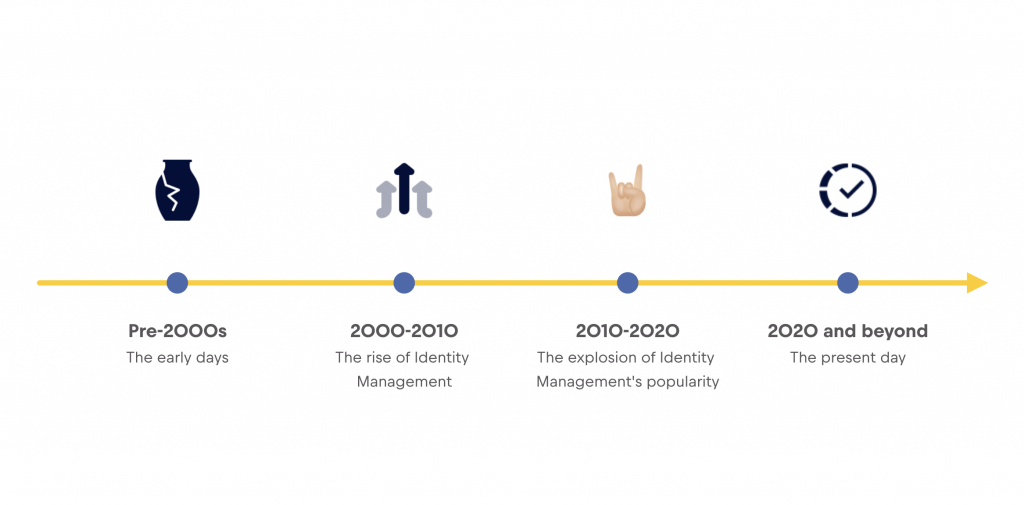Let’s take a look back at the key milestones in Identity Management over the years and learn how IDM evolved into a security essential. Hop in the time machine!
Estimated reading time: 5 minutes
Today, Identity Management (IDM) is an essential part of every organization’s security strategy. But how did we get here? How did IDM evolve from a niche solution to a crucial component of cybersecurity? Join us as we embark on a journey through time as we explore the timeline of Identity Management, its rise in popularity, and its current status in the market.

1st stop: The early days (pre-2000s)
The birth of digital identities
Before the rise of the internet, Identity Management was pretty straightforward. Individuals had physical identities—driver’s licenses, passports, and social security cards—but as the internet began to blossom, so did the need for digital identities. In the late 1990s, companies started recognizing that managing user access to various systems and applications was becoming more complex, particularly as organizations transitioned to online platforms.
The password era
In the early days of the internet, usernames and passwords were the go-to solutions for authenticating users. However, this simplistic approach soon revealed its flaws as cyber threats began to proliferate. Weak passwords became a common entry point for attackers, leading to the realization that more robust Identity Management practices were needed.
2nd stop: The rise of Identity Management (2000-2010)
Emergence of IAM solutions
By the early 2000s, the term Identity and Access Management (IAM) began to gain traction. Businesses recognized that managing user identities, authentication, and access control was critical for maintaining security in an increasingly digital landscape. IAM solutions started to emerge, offering organizations tools to manage user identities across various applications and platforms efficiently.
Compliance and regulatory pressure
Around the mid-2000s, compliance became a major driver of IDM. Regulations like the Health Insurance Portability and Accountability Act (HIPAA) and the Payment Card Industry Data Security Standard (PCI DSS) put pressure on organizations to ensure proper Identity Management practices. Companies began investing in IAM solutions to meet regulatory requirements and mitigate risks associated with data breaches.
3rd stop: The explosion of Identity Management’s popularity (2010-2020)
Cloud adoption and SSO solutions
With the rise of cloud computing, organizations began migrating their services and applications to the cloud, leading to an increased demand for Identity Management solutions. The need for seamless user experiences fueled the popularity of Single Sign-On (SSO) solutions, allowing users to log in once and access multiple applications without the hassle of remembering multiple passwords. This made IDM more user-friendly and efficient, propelling it into the mainstream.
Mobile Identity Management
As smartphones became ubiquitous, organizations faced new challenges in managing identities across mobile devices. The concept of mobile Identity Management emerged, enabling secure access to applications and data from mobile devices while ensuring user identity and security. This trend highlighted the need for IAM solutions that could adapt to a rapidly changing technological landscape.
Growing cyber threats
During this period, high-profile data breaches became more frequent, and organizations began to recognize the critical importance of Identity Management as a cybersecurity measure. Identity theft, credential stuffing, and phishing attacks heightened the urgency to adopt robust IAM practices. Organizations understood that proper IDM could significantly reduce the risk of unauthorized access and data breaches.
4th stop: The present day (2020 and beyond)
The shift to Zero Trust security
In recent years, the Zero Trust security model has emerged as a leading approach to Identity Management. The Zero Trust philosophy operates on the principle of “never trust, always verify.” This approach emphasizes strict identity verification for every user, regardless of their location, and often includes features like multi-factor authentication (MFA) and continuous monitoring. As organizations adopt this model, IDM has become even more critical to ensure secure access to resources.
The rise of decentralized Identity
Another exciting development in Identity Management is the concept of decentralized identity. This innovative approach allows individuals to manage their identities independently using technologies like blockchain. Decentralized identity solutions aim to give users greater control over their personal information while enhancing security and privacy. This trend is reshaping how organizations think about IDM, moving away from centralized databases to user-centric models.
Current trends and challenges
Today, Identity Management goes beyond user access, covering identity governance, lifecycle management, and privileged access. Organizations are now integrating IDM with security frameworks for a comprehensive cybersecurity approach.
However, challenges persist: managing identity sprawl, maintaining regulatory compliance, and countering evolving cyber threats. As cybercriminal tactics advance, Identity Management must stay ahead.
Final thoughts: A critical component of modern security
The journey of Identity Management from a niche solution to a fundamental aspect of cybersecurity reflects the changing landscape of technology and security threats. As we move forward, the importance of identity management will only continue to grow, with new technologies and approaches emerging to address the evolving challenges organizations face.
In a world where digital identities are constantly at risk, having a robust IDM strategy is no longer optional; it’s essential. By embracing innovation and staying ahead of the curve, organizations can ensure the security of their digital assets and maintain trust with their users. After all, in the realm of cybersecurity, a strong IDM framework is your best defense against the unknown!
